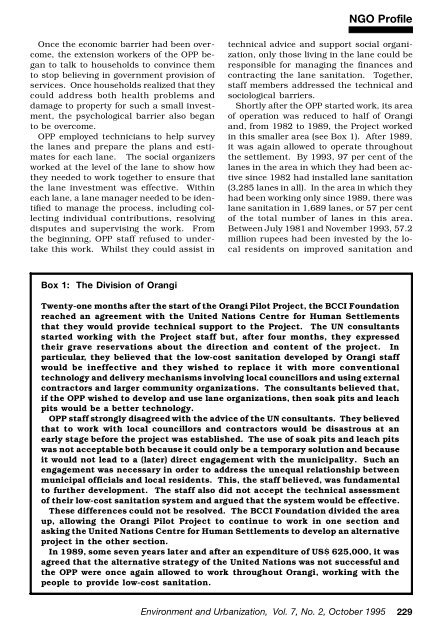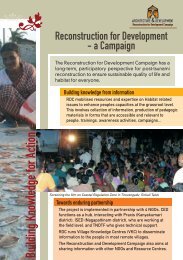Orangi Pilot Project
Orangi Pilot Project
Orangi Pilot Project
You also want an ePaper? Increase the reach of your titles
YUMPU automatically turns print PDFs into web optimized ePapers that Google loves.
NGO Profile<br />
Once the economic barrier had been overcome,<br />
the extension workers of the OPP began<br />
to talk to households to convince them<br />
to stop believing in government provision of<br />
services. Once households realized that they<br />
could address both health problems and<br />
damage to property for such a small investment,<br />
the psychological barrier also began<br />
to be overcome.<br />
OPP employed technicians to help survey<br />
the lanes and prepare the plans and estimates<br />
for each lane. The social organizers<br />
worked at the level of the lane to show how<br />
they needed to work together to ensure that<br />
the lane investment was effective. Within<br />
each lane, a lane manager needed to be identified<br />
to manage the process, including collecting<br />
individual contributions, resolving<br />
disputes and supervising the work. From<br />
the beginning, OPP staff refused to undertake<br />
this work. Whilst they could assist in<br />
technical advice and support social organization,<br />
only those living in the lane could be<br />
responsible for managing the finances and<br />
contracting the lane sanitation. Together,<br />
staff members addressed the technical and<br />
sociological barriers.<br />
Shortly after the OPP started work, its area<br />
of operation was reduced to half of <strong>Orangi</strong><br />
and, from 1982 to 1989, the <strong>Project</strong> worked<br />
in this smaller area (see Box 1). After 1989,<br />
it was again allowed to operate throughout<br />
the settlement. By 1993, 97 per cent of the<br />
lanes in the area in which they had been active<br />
since 1982 had installed lane sanitation<br />
(3,285 lanes in all). In the area in which they<br />
had been working only since 1989, there was<br />
lane sanitation in 1,689 lanes, or 57 per cent<br />
of the total number of lanes in this area.<br />
Between July 1981 and November 1993, 57.2<br />
million rupees had been invested by the local<br />
residents on improved sanitation and<br />
Box 1: The Division of <strong>Orangi</strong><br />
Twenty-one months after the start of the <strong>Orangi</strong> <strong>Pilot</strong> <strong>Project</strong>, the BCCI Foundation<br />
reached an agreement with the United Nations Centre for Human Settlements<br />
that they would provide technical support to the <strong>Project</strong>. The UN consultants<br />
started working with the <strong>Project</strong> staff but, after four months, they expressed<br />
their grave reservations about the direction and content of the project. In<br />
particular, they believed that the low-cost sanitation developed by <strong>Orangi</strong> staff<br />
would be ineffective and they wished to replace it with more conventional<br />
technology and delivery mechanisms involving local councillors and using external<br />
contractors and larger community organizations. The consultants believed that,<br />
if the OPP wished to develop and use lane organizations, then soak pits and leach<br />
pits would be a better technology.<br />
OPP staff strongly disagreed with the advice of the UN consultants. They believed<br />
that to work with local councillors and contractors would be disastrous at an<br />
early stage before the project was established. The use of soak pits and leach pits<br />
was not acceptable both because it could only be a temporary solution and because<br />
it would not lead to a (later) direct engagement with the municipality. Such an<br />
engagement was necessary in order to address the unequal relationship between<br />
municipal officials and local residents. This, the staff believed, was fundamental<br />
to further development. The staff also did not accept the technical assessment<br />
of their low-cost sanitation system and argued that the system would be effective.<br />
These differences could not be resolved. The BCCI Foundation divided the area<br />
up, allowing the <strong>Orangi</strong> <strong>Pilot</strong> <strong>Project</strong> to continue to work in one section and<br />
asking the United Nations Centre for Human Settlements to develop an alternative<br />
project in the other section.<br />
In 1989, some seven years later and after an expenditure of US$ 625,000, it was<br />
agreed that the alternative strategy of the United Nations was not successful and<br />
the OPP were once again allowed to work throughout <strong>Orangi</strong>, working with the<br />
people to provide low-cost sanitation.<br />
Environment and Urbanization, Vol. 7, No. 2, October 1995 229




